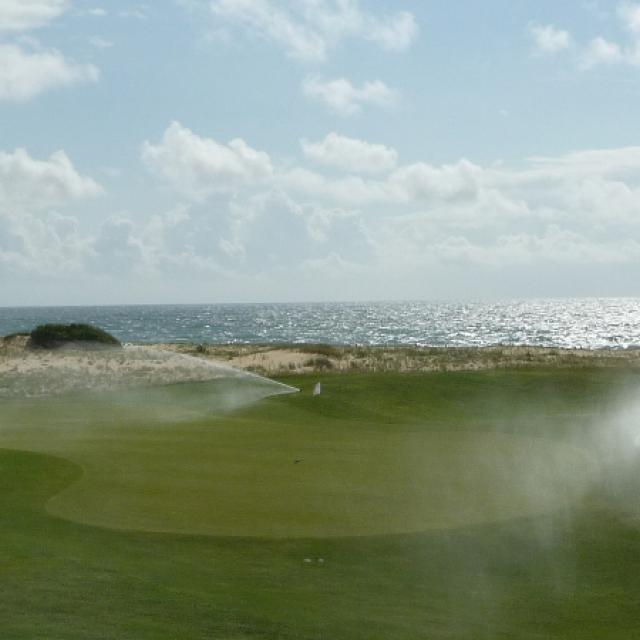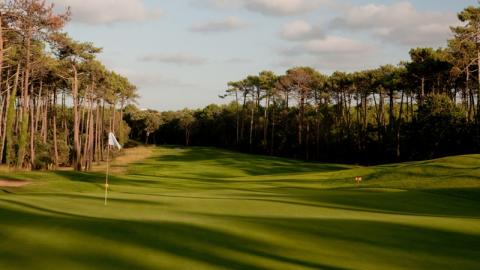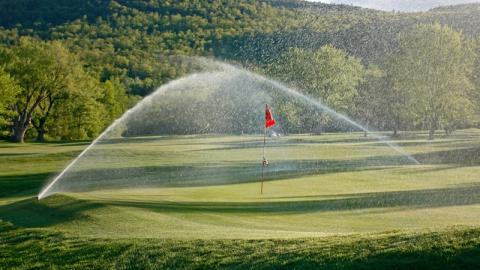On a sunny December morning, I went along to the Moliets Golf Course in the Landes, north of Biarritz. Welcomed at the club house by Didier Comte from the company Imagineur and Yvon Cessou from the company Arrosage System. I was immediately impressed by the beauty of the place. The undulating and impeccably maintained course is laid out amongst clumps of pine trees and traditional half-timbered Landes houses.

The Golf Course, designed by the architect Robert Trent Jones senior, is one of the most beautiful courses in the world. The site has one 18-hole course, a 9-hole course, two driving ranges, as well as an archery range and tennis courts. The local authority bought the site in the 1980s, i.e. 200 hectares in total. The Council kept 70 hectares of lawn and sold the rest to the company Pierre et Vacances company and to private developers, who have built the luxury houses that can be seen alongside the course. The company Imagineur, an irrigation design and engineering consultancy, was hired by the local authority to recreate the irrigation system for the golf course. Didier Comte won an invitation to tender put out by SATEL, on behalf of the joint syndicate. “The renovation of the 18 hole course was voted for last year, before the economic crisis”, explained Mr. Breton, the club director.In fact, the irrigation system installed in 1989, when the golf course was built, had become obsolete for a number of reasons. The course had been built in stages, the first nine holes first, then a second section of nine holes and finally the last nine holes. And at each new hole, a new borehole was drilled, the course totalling 24 boreholes! The Water Act of December 2006 now bans that type of practice. Furthermore, the very ferruginous nature of the water prematurely damaged the course sprinklers and pipes. The water was not filtered and went directly into the irrigation system. The sprinklers became blocked, the pipes became scaled or furred up… Three full-time employees spent their whole time looking for leaks and fixing them. “Previously, there was no irrigation management as such; we were simply maintaining an irrigation system,” explained Jean-Michel, the green keeper.
With the new installation, 24 boreholes came down to 3 boreholes.
We took a golf buggy and headed towards the new pumping station and the lagoon, which, as we were about to see, formed the heart of the installation. The 24 boreholes have been replaced by three boreholes. These three boreholes, located behind the station, pump water into the settling basins, in steps, and then a large water inlet channels direct the water from these ponds into the lake, where the water is once again settled. The lake, dug down into the water table, was enlarged during the construction works. The water is then taken from the lake back to the pumping station. “This arrangement has enabled the water quality to be improved considerably: it contains four times less iron than before,” explained Philippe, the hydraulic engineer. The station, a luxurious wooden building, houses a Grundfos pumping unit (6 pumps – 400 m3/h at 9 bar), and eight Arkal filters.
The electrical section is housed in another room, with speed variation for the pumps. The building is fitted with an efficient insulation system and a sound-proof door. A little further on, the technicians were busy laying turf on the bank alongside the lagoon.
These infrastructural works have considerably increased the cost of the site. The irrigation alone is costing 1,500,000 €. However, if we add to this the construction of the new road to provide access to the pumping station, the extension or enlargement of the lagoon, the construction of the permanent building, the settling ponds with oxygenation of the water and supplying electricity to the station, then the total cost climbs to 2,200,000 €.
“This arrangement has enabled the water quality to be improved considerably: it contains four times less iron than before”.
After putting out the tender for the irrigation works: Satel chose a group of specialist contracting firms: Arrosage System and Est Arro. With the work being carried out between January and March 2012, the first 9 holes are now finished (from number 10 to number 18).
At the present time, work is being carried out on the practice range and holes 1 to 9. The primary network has already been installed, this being completed between November and the Christmas holiday. “The trenches were dug by a mini excavator for the large diameters and subsoilers were used for diameters less than 110 mm”, explains Mr. Cessou, manager of Arrosage System. Work resumed at the beginning of January, concentrating solely on the irrigation aspect and this should be finished before Easter. The holes are being made one by one because players must always have 17 holes available for play. Moreover, the whole course must be available at the weekend. At the site meetings, everyone agreed on the schedule of works, taking into consideration another constraint: the Aquitaine Cup at the beginning of March. They mutually decided to start with holes 1, 2, 3, 4, 5 and 6, then holes 7, 8, 9 and finishing with holes 4, 5 and the practice range.
The new irrigation system will enable to use 20% less water
Bearing in mind the quality of the soil and the temperatures, it is essential to have a good irrigation system. In fact, the course is very large, exposed to wind, the summers are hot and the sandy soil characteristic of the Landes does not retain water. Once it is completed, the course will have a total of 1,743 golf course sprinklers, 93 small garden sprinklers and 40 kilometres of trenches, which is much more than the average for 18 hole courses (700 sprinklers and 20 kilometres of trenches). With the new Toro decoder system, each sprinkler is independent and can be individually controlled.
“The real financial benefits will be reaped 2 to 3 years from now, when the hydraulic engineer and the green keeper will have learned how to operate the whole system properly”, explained Didier Comte. “This saving is mainly due to the positioning of the sprinklers, with many adjustable sprinklers better placed and individually controlled thanks to the decoder system”. A saving of an additional 5 to 10% could be achieved when the hydraulic engineer and the green keeper get to know the system better, allowing them to make optimum use of the computer programming. Initially, a weather station was planned, but since the difference of the zones was too great between the sea and inland, they finally opted for moisture sensors allowing for manual readings to be taken and then “made to measure” sprinkling can be carried out.
We then drove off towards holes 13, 14 and 15, built along a magnificent wild sandy beach that extends as far as the eye can see. The holes are laid out amongst the dunes. The sky was slightly overcast and the wind was blowing much more strongly than inland. Philippe, the hydraulic engineer starts the irrigation system with his remote control.
Normally, the sprinkling should only cover the grass area, but some water finds its way onto the dunes, which enables the sand to be retained and it also helps the plants trampled underfoot by the golfers. The aim is to allow nature to take its course.
Mr. Comte tells us about the difficulty arising from the fact that the small 9-hole course is not part of the work schedule for the time being. The design integrates the whole site. The pumping station is powerful enough to cover the 18 holes, 9 holes, 2 practice ranges, tennis courts, archery range and the green spaces. However, budgetary constraints have meant that the renovation of the 9 hole course has had to be postponed until some time in the future. In fact, the water scheduling of the 9-hole course has nothing to do with the new scheduling and the central computer is not involved. This obliges the hydraulic engineer or the green keeper to work at different times and maintain just the flow-rate required for the 9-hole course. “As a first step, the programmer, at least, should be changed”, states Mr. Comte, “and ideally the whole system”.
Conclusion
Before this work started, water consumption was about 3,792 m3 per summer night, on the sand, for the whole site with 1,693 sprinklers, all supplied by twenty four boreholes… Now, water consumption will be about 3,000 m3 per summer night on the sand, with 1,743 golf course sprinklers and 93 small garden sprinklers, all supplied by the lagoon at hole 5 and three boreholes.
Specifications
• Project Manager: SATEL
• Engineering & Design consultants: Imaginieur
• Contractors: Est Arro and Arrosage System
• 40 kilometres of trenches
• 1,743 golf course sprinklers and 93 Toro small garden sprinklers
• Toro decoder system
Arrosage System, A PRESTIGIOUS GOLF COURSE CONTRACT FOR OUR COMPANY
In collaboration with the company Est Arro, our technicians have installed a top-quality system at this magnificent golf course. From the pumping station, to protecting the sprinklers on the sand dunes and selecting the special turf required in the more sensitive areas, no detail has been overlooked. The techniques now used for laying subsoil irrigation systems mean that we can make the course instantly available to the players, without there being any deterioration of the turf and greens.This is why we are so proud to hand over to our client such a high-performance sprinkler system.
An overview of the joint syndicate
The joint Syndicate set up for the combined tourist development zones of Moliets et Maa was established through a bylaw dated 1st July 1978 with the participation of the Departement of the Landes, of the one part, and the district of Moliets et Maâ, of the other part. Under the terms and conditions of its statutes, the object of the Joint Syndicate is to promote, direct and control all necessary activities required for the design and implementation of the development operations. Over recent years, the Joint Syndicate’s Board has become aware of the poor condition of the irrigation system, which has become seriously obstructed by the ferruginous nature of the water, despite carrying out certain preventative treatments. Before embarking upon any possible work, the Joint Syndicate, via an agency agreement, gave SATEL the task of carrying out a feasibility study to determine the appropriateness of the envisaged work, a schedule for any proposed work project and the technical solutions planned for the implementation of the work, as well as drawing up a provisional budget. The initial studies concluded that it would be necessary to renovate the whole irrigation system at the Moliets Golf Club. The estimated cost is put at 2.7 million euros, including taxes, for the renovation of the 18 hole course and practice range No. 2.


